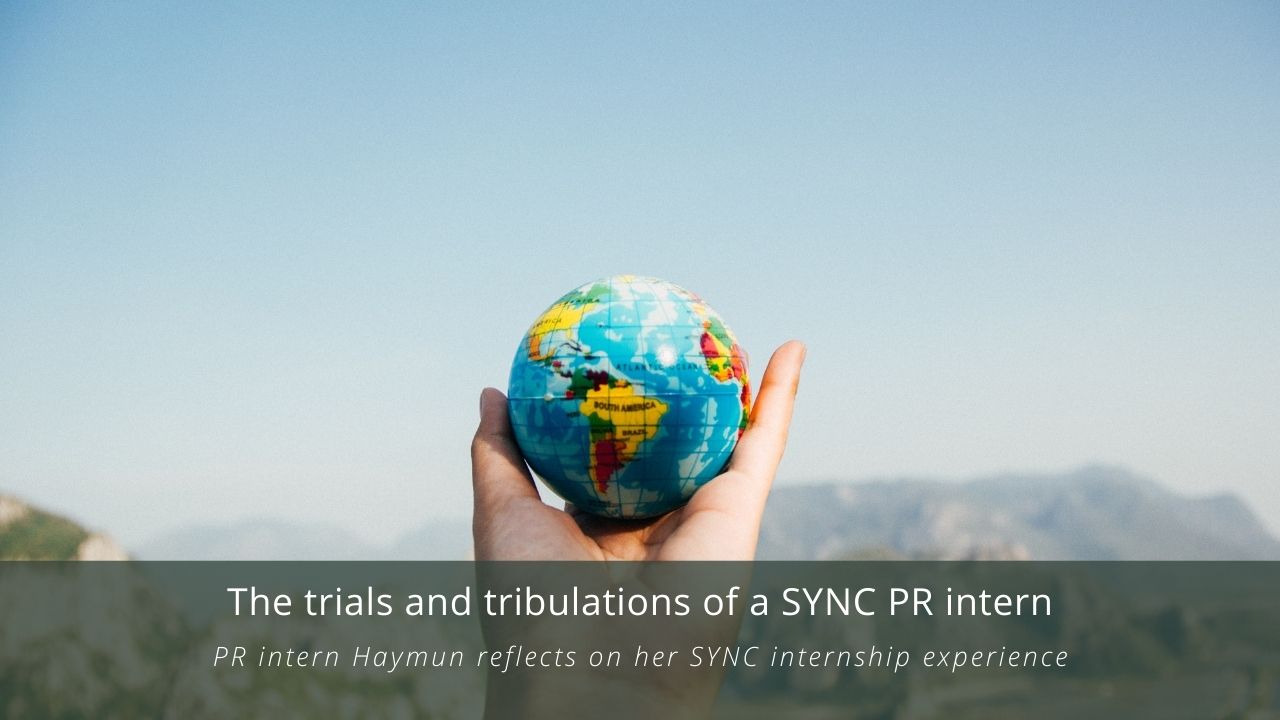This article is part of our series Watercooler Chat, where the SYNC PR team shares insights and opinions from their experience in the industry.
As a serial intern at various digital marketing agencies, I joined SYNC just to try my hand at PR and score some industry experience before I graduate. Taking on internships in university is a great way to give yourself a boost before your first full-time job, earn some extra cash and overload yourself (kidding!) at the same time. If you’re an overwhelmed undergraduate like me, internships let you experience different jobs and figure out your field of interest.
Two months of office gossip and many media pitches later, I’m writing my first Watercooler Chat article on my experience as a PR and content marketing intern in a growing agency. If you’re aspiring to take on a PR internship, here are my insights on entering PR, as seen through fresh eyes.
Startup PR agencies are built different

Let’s start off with a general one – finding the right agency is imperative to your internship learning experience. The right fit depends on many factors, such as your learning style, work environment preference and so on. Bigger agencies generally have more structured internship programmes but also tend to be more hierarchical, so expect to learn through listening and careful guidance.
My internship at SYNC is collaborative. As a startup agency, it’s all hands on deck. It gets hectic at times, but I personally learn better when I get thrown into the deep end. The culture of open communication means that my opinions and ideas are valued. More importantly, the startup work environment also nurtures innovation – I get to run point on certain projects (under supervision, of course) without being micromanaged. This gives me the freedom to exercise creativity and take risks, which is pretty uncommon for “just an intern”.
I’m glad I chose to intern in a startup agency. Although it might not be for everybody, independent learners like me will definitely take away a slice of agency life, lots of learning experience and a ton of good memories.
PR is so much more than a good network
I’ve always associated PR with extroverts who have the ability to chat anybody’s ear off. As someone with short social battery life, I was naturally never interested in PR. Traditional PR agencies rely heavily on their media network, but my experience in SYNC showed me that networking is secondary to quality content and pitching.
It is undeniable that an extensive network increases an agency’s access to the media. But with the technology and systems in place now, media contacts can be compiled with ease. What matters more is the quality of pitches, press releases and strategy. A standout media pitch will grab the attention of relevant journalists – even if they have never heard of you.
Working in a modern, result-driven and client-oriented environment has taught me that media coverage is not the end game. A mediocre pitch that gains media coverage solely due to the network an agency has might still garner low results for the client, in terms of their overall PR goals.
Read also: Common mistakes in PR: Are you hurting your publicity?
Media pitching pays off…eventually

Media pitching is an art. Like mastering any other form of art, it requires practice, precision and perseverance. Journalists sift through dozens of pitches every day and therefore only look at those that are relevant, newsworthy, snappy, structured and timely. I have come to realise that a good media pitch should be purposeful and give the journalist an idea of what the story looks like.
After developing a quality media pitch, the battle is still only half won. Following up with journalists is a regular part of the job, even if you’ve just sent out the most compelling media pitch in the world. Due to the sheer number of pitches that they receive, journalists might miss out on certain pitches. So PR practitioners thicken their skin and follow up through email, on the phone and then on the phone again.
From the perspective of a complete noob, I was amazed at the power of the bcc function and the amount of time it saved me, especially since personalising every email can get hairy. On that note, simply addressing every journalist by name doesn’t count as personalisation. It leaves a good impression when you personalise a pitch or a follow-up email extensively, keeping in mind why your pitch should interest their audience and add value to their publication.
Some call it job satisfaction, some call it character development. Either way, this process leads to an immense sense of achievement when you secure coverage.
We also share How to craft an excellent media pitch.
On creating compelling stories
As a Communications student, I’m aware that storytelling is the cornerstone of the media industry. PR is no exception – not every brand has an interesting story, but it’s up to PR practitioners to create one.
Storytelling can be done through photography, graphic design, animation and a variety of new media. In PR, you’re a wordsmith crafting speeches, quotes, interview answers, press releases and contributed articles.
A good story positions a brand in the minds of the consumers in a positive light. One thing I picked up is to never stop reading. SYNC services an arsenal of tech and startup clients around Southeast Asia, with most of our clients using as their PR agency in Singapore and Malaysia, a field I was unfamiliar with and frankly, disinterested in. I had a hard time unscrambling the jargon, but my interest was piqued and I got the hang of it after regularly reading various online tech publications. It also doesn’t hurt to have an in-depth knowledge of the publications that you’re pitching to.
Read also: How to perfect PR pitch angles using storytelling conventions.
My experience at SYNC imparted valuable advanced writing, strategic and account management skills onto me, all of which can be applied to a range of media-related jobs.
My advice: You’re not going to enjoy every aspect in your PR internship – some experiences might be underwhelming and some might be overwhelming – but you learn from everything. Worst-case scenario? You realise that you’d rather get hit by a bus than be in PR, and that’s something you never would’ve figured out without trying.
Want to know more about PR and content marketing? Speak to us at [email protected]


Very interesting and thanks for sharing such a good blog. Your article is so convincing that I never stop myself from saying something about it. You’re doing a great job. Keep it up.